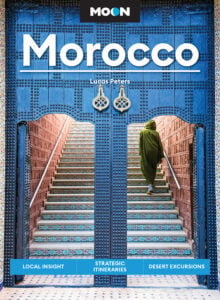Our team at Journey Beyond Travel was on the road filming the Telouet Kasbah in Moroco. We were fortunate enough to meet Sofia. She was once a regular performer to the Glaoui family and was famed for her traditional Berber (Amazigh) songs. She agreed to perform for us that day, and we were left feeling privileged to have watched her sing. Being presented with such a rare opportunity to witness a once in a lifetime performance, we decided to film Sofia so we could share the experience with others. Her amazing voice echoed within the intricately designed walls of the main room with the stunning mosaics and carvings gracefully complimenting her talent.
The Telouet Kasbah stands on the old caravan route towards the Sahara, between Ait Ben Haddou and Marrakesh. It is somehow an easily missed historical site, with visitors often passing by unaware as they leave Morocco’s world famous UNESCO world heritage site for the imperial city of Marrakech. But the Kasbah arguably boasts some of the best Islamic architecture in Morocco and should not be missed if passing through the High Atlas Mountains. With an interior so intricately designed and a history so gripping, many visitors are stunned by the rewards reaped when deciding to turn off and drive the dusty narrow paths leading up to the building.

French Support: Forgotten Power
Once the palatial residence to the Lords of the Atlas – the Glaoui family, the Kasbah now stands in ruins after the last Pasha fled following the departure of the French. In Morocco, a Pasha was the representative of the Sultan in a city or province. Thami El Glaoui, most commonly known as Thami Glaoui, is one of the best known as he was Pasha of Marrakech. Glaoui had supported the French during their occupation of Morocco, which earned him the mutual support of French colonial authorities in return. During the height of his career, Glaoui had held considerable power, making him one of the main political figures in the country.
The strategic location of the Kasbah illustrates the power and influence he held. With views over beautiful mountains green and peaceful Berber villages, it is easy to see why the family decided to build their Kasbah in this spot. Positioned on the passageway of merchant caravans and near prosperous salt mines, the Glaoui’s had the privilege of receiving gifts from those journeying past. But this privilege was a result of Thami El Glaoui’s brutal warlord and chieftain status. While some regard him as a fine man, many view him as a bloodthirsty traitor. He was one of two brothers who were sons of an Ethiopian slave woman. They were prominent brothers within the Glaoui tribe and by brute force they managed to rule much of Southern Morocco during the early twentieth century.
Thami El Glaoui’s commitment to the French turned against him during the independence of Morocco. After having being abandoned as they retreated from Morocco and branded a traitor by Moroccan nationalists, Glaoui had nowhere to turn and died in the Kasbah in 1956, only a few months after the declaration of independence. Through fear of jeopardizing Moroccan nationalists and due to the desire to maintain strong political commitment, the Kasbah remained abandoned for many years. Recent renovation of the Kasbah allows visitors to see its beautiful and intricately designed interior once again. Some rooms have been properly maintained and well looked after. The main rooms and reception areas, with Andalusian style decor, present an amazing illustration of the luxury in which Thami El Glaoui lived.
Amazing Art & Architecture

Legend has it, Glaoui commissioned 300 skilled craftsmen, who worked for 3 years to decorate the ceilings and walls. As you walk inside the main room, you will be stunned by its amazing mosaics and beautiful carvings. The craftsmen used “stucco” finely chopped and “Zellij” as colouring for the walls. Cedar was used for the ceiling and they tiled the roofs with green painted ceramic. The result of the hard craftsmanship is a mesmerizing building, whose interior at one time would have boasted significant wealth and prosperity. Much of the older sections of the Kasbah are in complete ruins, and many visitors find themselves lost as they walk through the crumbling passageways and ruins whilst exploring the dilapidated parts. Entrance to the Kasbah is around 10-20 Dirham and guides are often available to talk you through the history, allowing you to form your own opinions of the Glaoui family as you walk through this stunning site.
For those who wish to read more about the history of the Telouet Kasbah and the Glaoui family, we review Gavin Maxwell’s Lords of the Atlas (1965) and describe how the book provides a vivid portrait of the period, delving into the roles that both the French and Moroccans played.
How You Can Get to Telouet:
If you’d like to get off the beaten path, read about what we offer in Morocco! This is outlined in most of our itineraries in Morocco as an extra add-on. So, feel free to contact our team for an amazing cultural adventure with our on-the-ground team!
This video was filmed by Chris Griffiths and Thom Buttery. The photos were taken and the article written by filmmaker and travel journalist Chris Griffiths.
Hidden Morocco is a multimedia series showcasing some of the more easily missed destinations to discover while traveling in Morocco. Whether its the whitewashed fishing town of Asilah or the mesmerizing mosaic interior of the Telouet Kasbah, we aim to share with you some of our favorite, hidden-away places to get a true taste of Morocco. From photo essays to video features, explore Morocco’s better kept secrets with us by searching the archives with: hiddenmorocco








